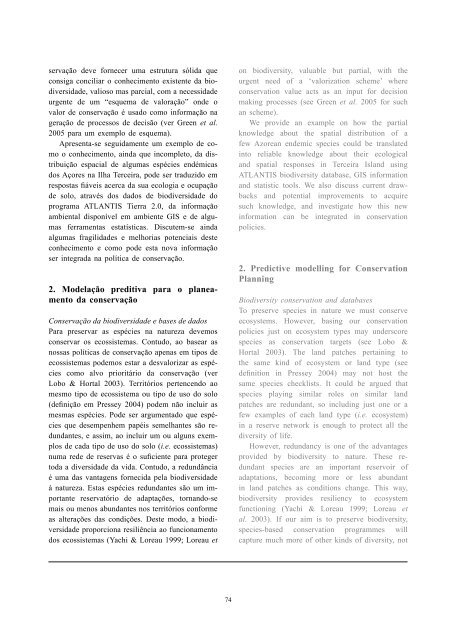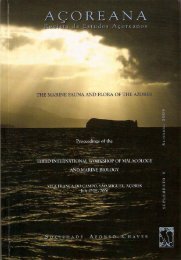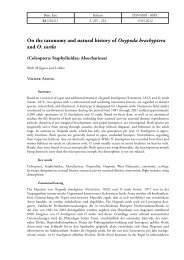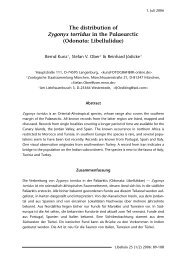(eds.) (2005). - Portal da Biodiversidade dos Açores - Universidade ...
(eds.) (2005). - Portal da Biodiversidade dos Açores - Universidade ...
(eds.) (2005). - Portal da Biodiversidade dos Açores - Universidade ...
Create successful ePaper yourself
Turn your PDF publications into a flip-book with our unique Google optimized e-Paper software.
servação deve fornecer uma estrutura sóli<strong>da</strong> que<br />
consiga conciliar o conhecimento existente <strong>da</strong> biodiversi<strong>da</strong>de,<br />
valioso mas parcial, com a necessi<strong>da</strong>de<br />
urgente de um “esquema de valoração” onde o<br />
valor de conservação é usado como informação na<br />
geração de processos de decisão (ver Green et al.<br />
<strong>2005</strong> para um exemplo de esquema).<br />
Apresenta-se segui<strong>da</strong>mente um exemplo de como<br />
o conhecimento, ain<strong>da</strong> que incompleto, <strong>da</strong> distribuição<br />
espacial de algumas espécies endémicas<br />
<strong>dos</strong> <strong>Açores</strong> na Ilha Terceira, pode ser traduzido em<br />
respostas fiáveis acerca <strong>da</strong> sua ecologia e ocupação<br />
de solo, através <strong>dos</strong> <strong>da</strong><strong>dos</strong> de biodiversi<strong>da</strong>de do<br />
programa ATLANTIS Tierra 2.0, <strong>da</strong> informação<br />
ambiental disponível em ambiente GIS e de algumas<br />
ferramentas estatísticas. Discutem-se ain<strong>da</strong><br />
algumas fragili<strong>da</strong>des e melhorias potenciais deste<br />
conhecimento e como pode esta nova informação<br />
ser integra<strong>da</strong> na política de conservação.<br />
2. Modelação preditiva para o planeamento<br />
<strong>da</strong> conservação<br />
Conservação <strong>da</strong> biodiversi<strong>da</strong>de e bases de <strong>da</strong><strong>dos</strong><br />
Para preservar as espécies na natureza devemos<br />
conservar os ecossistemas. Contudo, ao basear as<br />
nossas políticas de conservação apenas em tipos de<br />
ecossistemas podemos estar a desvalorizar as espécies<br />
como alvo prioritário <strong>da</strong> conservação (ver<br />
Lobo & Hortal 2003). Territórios pertencendo ao<br />
mesmo tipo de ecossistema ou tipo de uso do solo<br />
(definição em Pressey 2004) podem não incluir as<br />
mesmas espécies. Pode ser argumentado que espécies<br />
que desempenhem papéis semelhantes são redun<strong>da</strong>ntes,<br />
e assim, ao incluir um ou alguns exemplos<br />
de ca<strong>da</strong> tipo de uso do solo (i.e. ecossistemas)<br />
numa rede de reservas é o suficiente para proteger<br />
to<strong>da</strong> a diversi<strong>da</strong>de <strong>da</strong> vi<strong>da</strong>. Contudo, a redundância<br />
é uma <strong>da</strong>s vantagens forneci<strong>da</strong> pela biodiversi<strong>da</strong>de<br />
à natureza. Estas espécies redun<strong>da</strong>ntes são um importante<br />
reservatório de a<strong>da</strong>ptações, tornando-se<br />
mais ou menos abun<strong>da</strong>ntes nos territórios conforme<br />
as alterações <strong>da</strong>s condições. Deste modo, a biodiversi<strong>da</strong>de<br />
proporciona resiliência ao funcionamento<br />
<strong>dos</strong> ecossistemas (Yachi & Loreau 1999; Loreau et<br />
74<br />
on biodiversity, valuable but partial, with the<br />
urgent need of a ‘valorization scheme’ where<br />
conservation value acts as an input for decision<br />
making processes (see Green et al. <strong>2005</strong> for such<br />
an scheme).<br />
We provide an example on how the partial<br />
knowledge about the spatial distribution of a<br />
few Azorean endemic species could be translated<br />
into reliable knowledge about their ecological<br />
and spatial responses in Terceira Island using<br />
ATLANTIS biodiversity <strong>da</strong>tabase, GIS information<br />
and statistic tools. We also discuss current drawbacks<br />
and potential improvements to acquire<br />
such knowledge, and investigate how this new<br />
information can be integrated in conservation<br />
policies.<br />
2. Predictive modelling for Conservation<br />
Planning<br />
Biodiversity conservation and <strong>da</strong>tabases<br />
To preserve species in nature we must conserve<br />
ecosystems. However, basing our conservation<br />
policies just on ecosystem types may underscore<br />
species as conservation targets (see Lobo &<br />
Hortal 2003). The land patches pertaining to<br />
the same kind of ecosystem or land type (see<br />
definition in Pressey 2004) may not host the<br />
same species checklists. It could be argued that<br />
species playing similar roles on similar land<br />
patches are redun<strong>da</strong>nt, so including just one or a<br />
few examples of each land type (i.e. ecosystem)<br />
in a reserve network is enough to protect all the<br />
diversity of life.<br />
However, redun<strong>da</strong>ncy is one of the advantages<br />
provided by biodiversity to nature. These redun<strong>da</strong>nt<br />
species are an important reservoir of<br />
a<strong>da</strong>ptations, becoming more or less abun<strong>da</strong>nt<br />
in land patches as conditions change. This way,<br />
biodiversity provides resiliency to ecosystem<br />
functioning (Yachi & Loreau 1999; Loreau et<br />
al. 2003). If our aim is to preserve biodiversity,<br />
species-based conservation programmes will<br />
capture much more of other kinds of diversity, not

















